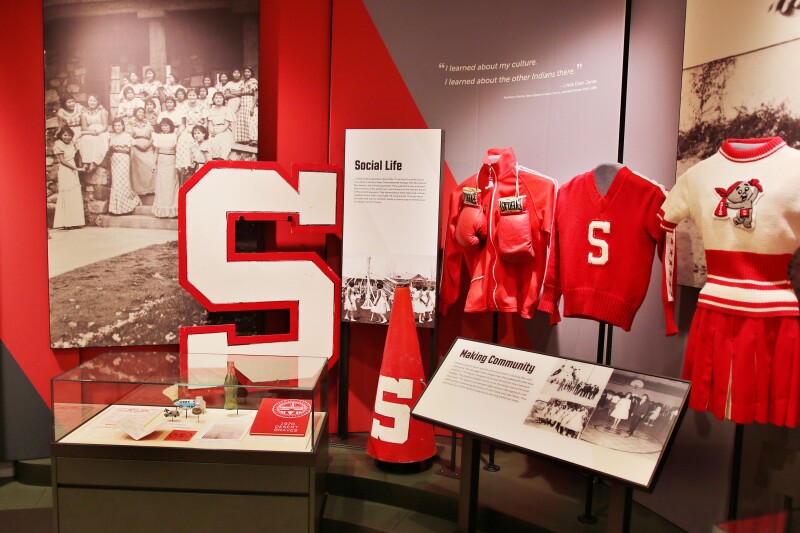Note: Though COVID-19 has stalled a lot of travel plans, we hope our stories can offer inspiration for your future adventures—and a bit of hope.
From Maryland to Nevada, this array of new museums and exhibitions speaks to the many experiences of underrepresented voices in the United States, among them Muslim Chicagoans, Jews in the South, and female-identifying artists.

Uniforms from Stewart Indian School are on display at the former site, which is now a cultural center and museum.
Photo by Larry Burton/Stewart Indian School Cultural Center and Museum
Stewart Indian School Cultural Center and Museum
Carson City, Nevada
One of the uglier chapters in U.S. history involved the forced assimilation of American Indian children, who were taken from their families and reservations and shipped off to government-run boarding schools. One such institution was the Stewart Indian School in western Nevada, which operated from 1890 until 1980. Following years of lobbying by alumni and tribal leaders, the school opened as a cultural center and museum in January. A permanent exhibit on the school’s history displays school desks, a basketball from the school’s 1966 state championship team, band uniforms and instruments, and audio and video recordings of former students talking about their experiences. A research room showcases yearbooks, tribal books, and photographs of the work of Hopi stonemasons and students; a storytelling room with children’s books from Nevada tribes offers a dedicated space for tribe members to share stories or lead crafting classes. The cultural center’s Wa-Pai-Shone Gallery features works by contemporary Great Basin Native American artists.

Aretha Franklin is one of the many African American artists celebrated at the National Museum of African American Music, opening later in 2020.
Photo by David Redfern/Redferns/Getty Images
National Museum of African American Music
Nashville, Tennessee
When the NMAAM opens its doors in early September, it will be the only museum dedicated to preserving and celebrating more than 50 genres and styles of music created or inspired by African Americans under one roof. The museum will use interactive displays to demonstrate this rich history, covering slavery songs, religious hymns, gospel, blues, contemporary R&B, hip-hop, and more. Visitors will be able to experiment with beat-making via touch screens, sing along with the voices of gospel singer and television host Bobby Jones and the Nashville Super Choir, and get an up-close look at traditional African drums, Whitney Houston’s leopard-print gown, and jazz musician Kirk Whalum’s saxophone.
Museum of the Southern Jewish Experience
New Orleans, Louisiana
Jewish immigrants settled all over the country—including in the Bible Belt. The MSJE was founded in 1986 at a Mississippi summer camp but closed in 2012. The new version will open late this fall in a multilevel space in the heart of New Orleans. Through hands-on exhibitions, archival documents, oral histories, and highlights from a collection of more than 4,000 artifacts, the museum will explore the ways that Jews living in Charleston, Savannah, Mobile, Houston, New Orleans, and other Southern communities influenced and were influenced by the cultural heritage of their new homes.
Harriet Tubman Museum
Cape May, New Jersey
Although abolitionist Harriet Tubman is commonly linked to Maryland, she lived in Cape May for three summers in the early 1850s, toiling as a cook to help fund her work on the Underground Railroad. In a restored parish home, the Harriet Tubman Museum is set to open on June 19, 2020—a date also known as Juneteenth, which commemorates the effective end of slavery in the United States. In addition to documenting Tubman’s life and the crucial role Cape May played in the fight to end slavery, the new museum will house historic African art and exhibits on the late Rev. Robert Davis, who lived in the home while serving the Macedonia Baptist Church next door.

The Baltimore Museum of Art is featuring artwork by female-identifying artists until 2021 for a special exhibition.
Photo by Jason Varney/Visit Baltimore
2020 Vision at the Baltimore Museum of Art
Baltimore, Maryland
With its 2020 Vision initiative, the BMA made a commitment to spend $2.5 million this year to acquire and exhibit art made by female-identifying artists. Highlights include an installation by Mickalene Thomas, a survey of Joan Mitchell’s painting career, video art by Candice Breitz, and displays of works by Valerie Maynard and other Baltimore-based artists. The effort coincides with the 100th anniversary of the 19th Amendment, which granted U.S. women the right to vote, though in practice, barriers remained for minorities.

At the Chicago History Museum, “American Medina” presents stories from Chicago’s Muslim community.
Photo by Chicago History Museum
American Medina: Stories of Muslim Chicago at the Chicago History Museum
Chicago, Illinois
Muslims have a long history in the United States, and in Chicago in particular. Running through May 2021 and drawing from more than 100 interviews conducted with Muslim Chicagoans, the exhibition American Medina: Stories of Muslim Chicago shares a diverse collection of personal journeys and perspectives on faith and identity. Visitors hear from Chicago police chaplain Hysni Selenica, lantern store owner Yousef Barakat, and baker Imani Muhammad, among others. Religious garments, artwork, photographs, videos, and interactive displays further explain how Islam and this Midwestern city came to be so deeply intertwined.

Visitors can engage with interactive digital parts of the exhibition at the Chinese American Museum.
Photo by the Chinese American Museum Foundation
Chinese American Museum
Washington, D.C.
CAMDC celebrates the nearly 200-year legacy of Chinese immigrants in the United States. As the museum builds out its new home adjacent to the Jefferson Hotel, it is already hosting temporary exhibits there, including Safe Harbor: Shanghai, which tells the surprising story of Jewish refugees who found sanctuary in China during World War II, and another that explores the crucial role of Chinese American women throughout U.S. history. On the first floor, visitors can test out the new digital timeline and photo wall as the museum prepares to open new exhibition spaces in late 2020.
>>Next: Virtual Museum Tours, Performances, and Tutorials to Keep You (and Your Kids) Entertained at Home











